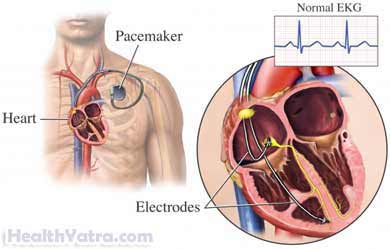সংজ্ঞা
A doctor guides robotic arms to do surgery on the heart. The surgery is done through several tiny keyhole incisions.
পদ্ধতির কারণ
Robot-assisted cardiac procedures are done to treat a variety of conditions:
- Robot-assisted mitral valve repair may be used to treat:
- Stenosis (narrowing) of the mitral valve
- Regurgitation (leakage) of the mitral valve
- Robot-assisted coronary artery bypass grafting (CABG) may be used to treat:
- Blockages in the heart’s arteries
- Severe chest pain ( angina) that has not improved with medicines
- Robot-assisted Atrial Septal খুঁত repair may be used to treat a hole between the upper chambers of the heart that does not close properly during fetal development.
- Robot-assisted biventricular pacemaker lead placement may be used to treat heart failure due to atrial fibrillation (irregular heart rhythm in the upper chambers of the heart).

Benefits of robot-assisted cardiac procedures may include:
- Increased range of motion with the robotic arms
- Ability to filter out human hand tremor and translate the doctor’s larger hand movements into smaller ones
- Reduced trauma to the body
- Shorter hospital stay
- Faster recovery
সম্ভাব্য জটিলতা
Complications are rare, but no procedure is completely free of risk. If you are planning to have a robot-assisted cardiac procedure, your doctor will review a list of possible complications, which may include:
- Damage to neighboring organs or structures in the chest
- সংক্রমণ
- রক্তপাত
- রক্ত জমাট
- এনেস্থেশিয়া সংক্রান্ত সমস্যা
- মৃত্যু
জটিলতার ঝুঁকি বাড়াতে পারে এমন কিছু কারণের মধ্যে রয়েছে:
- Prior heart attack or heart surgery
- উন্নত বয়স
- ডায়াবেটিস
- স্থূলতা
- ধূমপান
- অতিরিক্ত অ্যালকোহল গ্রহণ
- Uncontrolled thyroid disease
অস্ত্রোপচারের আগে আপনার ডাক্তারের সাথে এই ঝুঁকিগুলি নিয়ে আলোচনা করতে ভুলবেন না।
কি আশা করা যায়
পদ্ধতির আগে
Depending on the reason for your surgery, your doctor may do the following:
- শারীরিক পরীক্ষা
- রক্ত এবং প্রস্রাব পরীক্ষা
- Electrocardiogram (ECG, EKG) —a test that records the electrical currents passing through the heart muscle
- Coronary angiogram —a test to determine the extent and location of blockages of blood vessels supplying the heart muscle
- বুকের এক্স-রে - একটি পরীক্ষা যা বুকের ভিতরের কাঠামোর ছবি তুলতে বিকিরণ ব্যবহার করে
- Ultrasound —a test that uses sound waves to visualize structures inside the chest
- CT scan —a type of x-ray that uses a computer to create images of structures inside the chest
- MRI scan —a test that uses magnetic waves to make pictures of structures inside the chest
পদ্ধতি পর্যন্ত নেতৃত্ব:
- Talk to your doctor about your medicines. You may be asked to stop taking some medicines up to one week before the procedure, such as:
- প্রদাহ বিরোধী ওষুধ (যেমন, অ্যাসপিরিন)
- Blood thinners, like clopidogrel (Plavix) or warfarin (Coumadin)
- Take antibiotics if instructed.
- Follow a special diet if instructed.
- Shower the night before using antibacterial soap if instructed.
- Arrange for someone to drive you home from the hospital. Also, have someone to help you at home.
- আগের রাতে হালকা খাবার খান। খাওয়া বা মধ্যরাত্রি পরে কিছু পান করবেন না।
এনেস্থেশিয়া
There are two options for anesthesia:
- General anesthesia —blocks pain and keeps you asleep through the surgery
- Local anesthesia with sedation—just the area that is being operated on is numbed, given as an injection
পদ্ধতির বর্ণনা
The doctor will cut several keyhole openings in the spaces between the ribs. Next, the doctor will pass a small camera through one of the incisions. This small camera is called an endoscope. It will light, magnify, and project an image of the organs onto a monitor. The endoscope will be attached to one of the robotic arms. The other arms will hold instruments for grasping, cutting, dissecting, and suturing. These may include:
- Forceps
- Scissors
- Dissectors
- Scalpels
While sitting at a console near the operating table, the doctor will look through lenses. He will see magnified 3D images of the inside of the chest. Another doctor will stay by the operating table and adjust the camera and instruments. The console will have joystick hand controls and foot pedals. Using these, the doctor will guide the robotic arms and instruments. After the instruments are removed, incisions will be closed with sutures or staples.
অবিলম্বে প্রক্রিয়া পরে
After the procedure, you will be:
- Moved to the intensive care unit (ICU)
- Closely monitored
- Encouraged to sit up and move around soon after surgery
কতক্ষণ এটা লাগবে?
Usually 1-4 hours (depending on the procedure)
এটা কতটা আঘাত করবে?
You will have pain and soreness during recovery. Ask your doctor about pain medicine.
গড় হাসপাতালে থাকার
This procedure is done in a hospital setting. The usual length of stay is dependent on the procedure you had done. Your doctor may need to keep you longer if you have any problems.
পোস্ট-প্রক্রিয়া যত্ন
আপনি যখন বাড়িতে ফিরে আসবেন, একটি মসৃণ পুনরুদ্ধার নিশ্চিত করতে নিম্নলিখিতগুলি করুন:
- Follow your doctor’s guidelines on taking medicine. You may need to take antibiotics.
- Do deep breathing and coughing exercises.
- একটি বিশেষ খাদ্য অনুসরণ করুন।
- Wash the incisions with mild soap and water.
- কখন গোসল করা, গোসল করা বা জলে ভিজানো নিরাপদ সে সম্পর্কে আপনার ডাক্তারকে জিজ্ঞাসা করুন।
- Limit certain activities (eg, driving, strenuous activity).
- Enroll in a cardiac rehabilitation program.
- আপনার ডাক্তারের নির্দেশাবলী অনুসরণ করতে ভুলবেন না।
আপনার ডাক্তারকে কল করুন
আপনি হাসপাতাল ছেড়ে যাওয়ার পরে, নিম্নলিখিতগুলির মধ্যে যেকোনটি ঘটলে আপনার ডাক্তারের সাথে যোগাযোগ করুন:
- জ্বর এবং ঠাণ্ডা সহ সংক্রমণের লক্ষণ
- Redness, swelling, increasing pain, excessive bleeding, or discharge from an incision site
- কাশি, শ্বাসকষ্ট বা বুকে ব্যথা
- Difficulty urinating, such as pain, burning, urgency, frequency, or bleeding
- মারাত্মক বমি বমি ভাব বা বমি হওয়া
- Rapid weight gain
- আপনার পা, বাছুর বা পায়ে ব্যথা এবং/অথবা ফোলা
- Headache, feeling faint or dizzy
- Other worrisome symptoms
জরুরী পরিস্থিতিতে, অবিলম্বে চিকিৎসা সহায়তার জন্য কল করুন।
